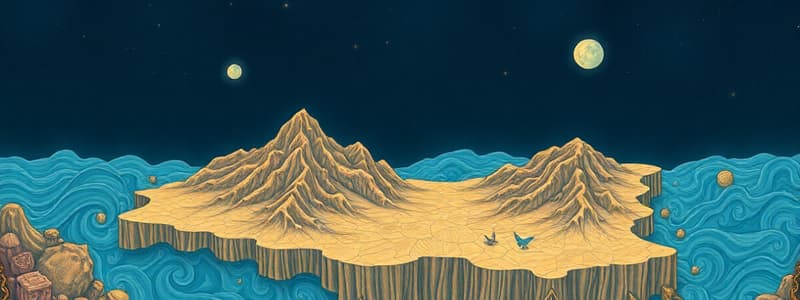Podcast
Questions and Answers
The Earth's lithosphere is best described as:
The Earth's lithosphere is best described as:
- A dense, metallic core at the Earth's center, generating the planet's magnetic field.
- A continuous, unbroken shell of solid rock forming the Earth's outer layer.
- Fragmented into several pieces that move and interact, carrying continents and ocean floors. (correct)
- A layer of molten rock beneath the Earth's crust, responsible for volcanic activity.
Alfred Wegener's continental drift hypothesis was initially met with skepticism primarily because:
Alfred Wegener's continental drift hypothesis was initially met with skepticism primarily because:
- He lacked a convincing mechanism to explain how continents could move across the Earth. (correct)
- Technological limitations of the time prevented accurate measurements of continental movement.
- His proposed supercontinent, Pangaea, was geographically impossible based on existing maps.
- The fossil evidence he presented was later proven to be inaccurate and misinterpreted.
Seafloor spreading, a key process in plate tectonics, is characterized by:
Seafloor spreading, a key process in plate tectonics, is characterized by:
- The movement of continental crust over oceanic crust, causing continents to collide and form mountains.
- The destruction of oceanic crust at mid-ocean ridges, leading to the formation of deep trenches.
- The creation of new oceanic crust at mid-ocean ridges as magma rises and pushes older crust apart. (correct)
- The sinking of continental crust into the mantle at subduction zones, recycling old continental material.
The discovery of Lystrosaurus fossils on multiple, geographically separated continents provides evidence for:
The discovery of Lystrosaurus fossils on multiple, geographically separated continents provides evidence for:
Henry Hess's theory of seafloor spreading significantly advanced the acceptance of continental drift by:
Henry Hess's theory of seafloor spreading significantly advanced the acceptance of continental drift by:
Flashcards
Plate Tectonics
Plate Tectonics
The theory that Earth's lithosphere is divided into plates that move, driven by forces in the mantle.
Continental Drift
Continental Drift
The hypothesis that continents were once joined and have gradually moved apart.
Alfred Wegener
Alfred Wegener
Scientist who proposed the continental drift hypothesis in the early 1900s, backed by fossil and land feature evidence.
Seafloor Spreading
Seafloor Spreading
Signup and view all the flashcards
Lystrosaurus Fossils
Lystrosaurus Fossils
Signup and view all the flashcards
Study Notes
- Earth has multiple tectonic plates that move in different directions, creating various phenomena.
- The lithosphere is broken into tectonic plates that carry continents and parts of the ocean floor.
- Plate tectonics theory states that Earth's lithosphere is made of tectonic plates in slow, constant motion, driven by forces in the mantle.
History of Plate Tectonics
- In the late 1800s, Alfred Wegener hypothesized that continents move, calling it continental drift. Evidence for continental drift included matching land features (mountain ranges of Africa and South America), matching coal fields in Europe and North America, and fossils on different continents.
- Lystrosaurus fossils found in Africa and Antarctica supported continental drift.
- Henry Hess proposed the idea of seafloor spreading to explain continent movement.
- Seafloor spreading occurs as molten material enters along mid-ocean ridges, pushing old crust outward and forming new oceanic crust.
- Evidence for seafloor spreading includes molten material eruptions (volcanoes), magnetic stripes in oceanic rocks, and the ages of oceanic rocks.
- Earth's magnetic poles have reversed many times, recorded in "striped" seafloor rocks.
Causes of Tectonic Plate Movement
- Mantle convection is a mechanism of plate movement, where materials move in currents due to differences in heat and density.
- During convection, heated particles circulate, with hot particles rising and cold particles sinking.
- Ridge push is another theory, where magma rises to form new oceanic crust at mid-ocean ridges, pushing older rock downward and away.
- New rock cools, becomes dense, and falls downward due to gravity.
- Slab pull occurs when dense tectonic plates sink beneath less dense plates, creating a pull on the rest of the plate.
- Subducting plates create the fastest tectonic plate movement.
Types of Tectonic Plate Movement
- Plates move in three main ways: divergent, convergent, or transform plate boundaries.
- Changes in Earth's crust happen along plate boundaries at a rate of one to ten centimeters per year.
- Divergent boundaries occur when two plates move away from each other, often along mid-ocean ridges or as rift valleys on land (e.g., Great Rift Valley in Africa).
- Convergent plate boundary is where two plates collide.
- In continent-continent collisions, plates push against each other, creating mountains.
- In continent-ocean collisions, the oceanic plate sinks beneath the continental plate.
- In ocean-ocean collisions, the denser plate sinks below the less dense plate.
- Transform boundaries involve two plates sliding past each other horizontally, causing friction and earthquakes (e.g., San Andreas Fault).
Effects of Tectonic Plate Movement
- Plate movement causes short-term and long-term changes, including volcanic activity, earthquakes, mountain building, and continent movement over millions of years.
- All continents were once part of a large landmass called Pangaea, which slowly moved apart.
- Energy affects tectonic plate movement, creating mountains through folding, volcanic activity, or faulting.
- Uplift causes land to rise and create mountains (e.g., Appalachian Mountains).
- Divergent and convergent plate boundaries, as well as hot spots, can form volcanoes.
- The Hawaiian Islands were formed through hot-spot activity, where a mantle plume rises through the asthenosphere and lithosphere.
- Tectonic plates move over these fixed plumes, forming volcanoes.
- Stress from plate movements creates breaks in Earth's crust called faults.
- Earthquakes are the release of energy when faulting occurs.
Studying That Suits You
Use AI to generate personalized quizzes and flashcards to suit your learning preferences.
Description
The lithosphere is divided into tectonic plates that move, causing geological phenomena. Wegener's continental drift theory, supported by land features and fossils, was a precursor to plate tectonics. Seafloor spreading explains the movement of continents.




